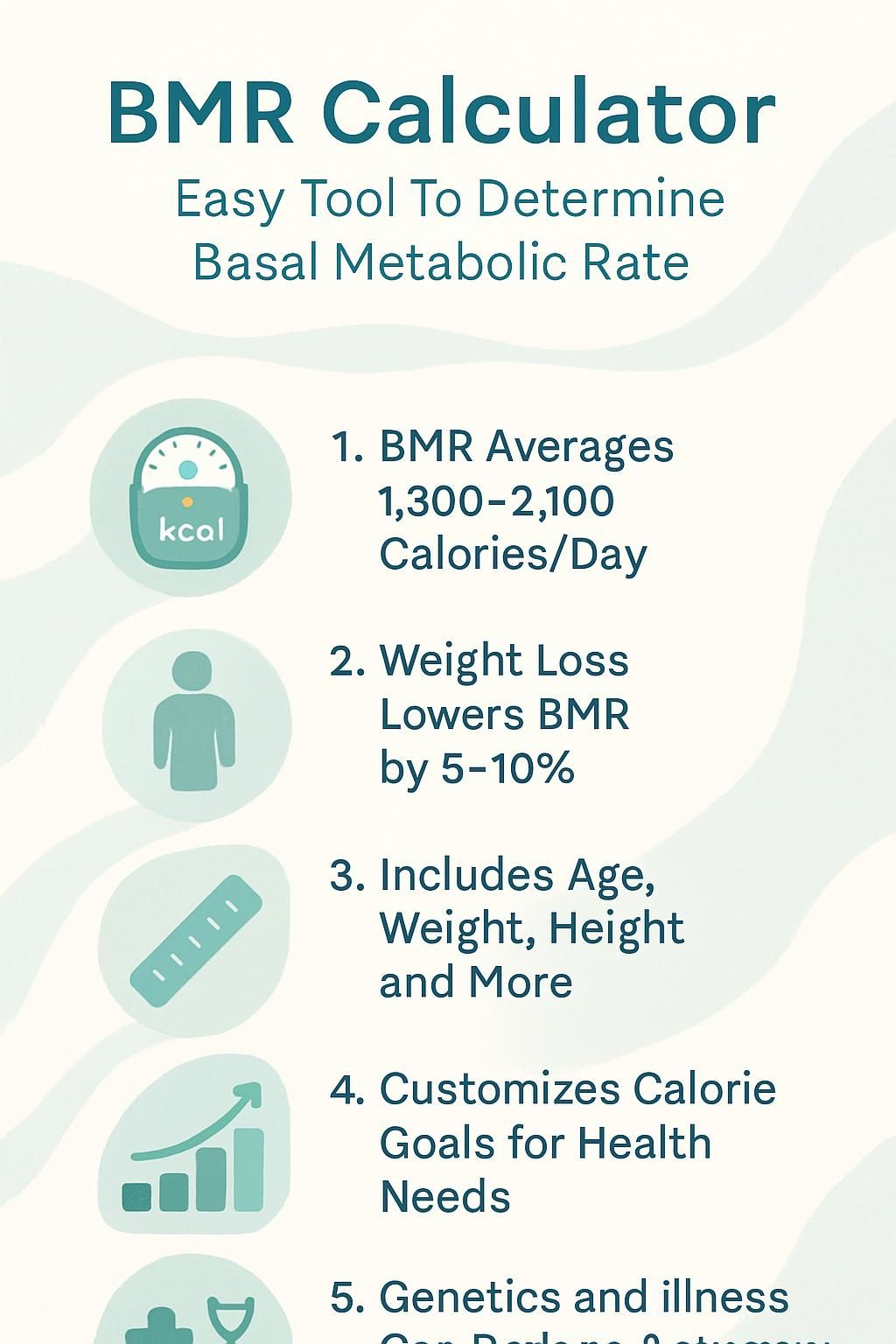BMR Calculator: Easy Tool To Determine Basal Metabolic Rate
Our Nutrition Assistant AI Suite will transform your body. You will lose fat, get toned, and build muscle. Gain confidence and optimal health.
Many people want to know how many calories their body burns at rest. Using a BMR calculator gives a fast, clear estimate of basal metabolic rate, which is your body’s energy use at rest. It reflects how many calories your body needs to keep the heart beating, lungs breathing, and body temperature steady.
Clinical BMR is measured after a 12-hour fast in a calm, neutral room. Most of us will not do a lab test, so I use formulas that are validated and easy to apply. In this guide, I explain what BMR means, why it matters, how to estimate it with the Mifflin-St Jeor equation or the Harris-Benedict equation, and how to use your number for daily choices that support health and weight goals.
If you want a dependable estimate of how many calories your body burns at rest, keep reading.
Key Takeaways
- BMR calculators estimate basal metabolic rate using inputs like age, sex, height, weight, and sometimes body fat, with formulas such as Mifflin-St Jeor (1990) and Revised Harris-Benedict (1984).
- BMR usually accounts for 60 to 70 percent of daily calories burned; averages are about 1,300 to 1,600 Calories per day for many women and 1,700 to 2,100 for many men.
- Weight loss often lowers BMR by about 5 to 10 percent below predictions due to metabolic adaptation, which can equal 30 to 100 fewer Calories per day.
- Accurate BMR estimates help set calorie deficits for fat loss or surpluses for muscle gain; this supports better weight management.
- Genetics, age over 60, muscle mass changes, illness, pregnancy, and menopause can shift BMR meaningfully.

Understanding the BMR Calculator

A BMR calculator estimates your basal metabolic rate from simple inputs such as age, weight, height, and sex. Knowing how many calories your body burns at rest helps you plan daily energy intake with confidence.
What is Basal Metabolic Rate (BMR)?
Basal Metabolic Rate is the number of calories your body uses at rest after a 12-hour fast in a neutral setting. These calories support basic life functions like heartbeat, breathing, and maintaining body temperature.
BMR often makes up around 70 percent of daily energy use. Vital organs like the brain, liver, kidneys, and heart are a small share of body mass but drive much of this burn. Typical BMR values are about 1,300 to 1,600 Calories per day for women and 1,700 to 2,100 for men. Some very muscular athletes can measure near 3,700 per day, while severe illness or extreme underweight states can push values below 700.
Knowing your BMR gives a baseline before adding activity or exercise. It is the starting number for any calorie plan.
What Are the Benefits of Using a BMR Calculator?
After I learned what BMR means, the calculator became a go-to tool. It estimates how many calories my body needs to run basic systems at rest. I can choose US or Metric units and switch formulas like Mifflin-St Jeor, Harris-Benedict, or Katch-McArdle when body fat data is available.
The tool factors in key details and returns Calories or Kilojoules with a realistic range. These estimates help me set targets for weight loss, maintenance, or muscle gain. Updating inputs over time keeps my plan aligned with real-life changes.
Operating a BMR Calculator
You can use the calculator to estimate how many calories your body needs at rest each day. Having my BMR gives me a strong starting point for calorie planning and progress tracking.
What Inputs Are Needed to Calculate BMR?
Accurate inputs lead to better estimates. Here is what I enter each time.
- Age, usually between 15 and 80 years, since metabolism changes with life stage.
- Sex, male or female, because hormones and body composition affect BMR.
- Height, in feet and inches or centimeters, since larger bodies need more energy.
- Weight, in pounds or kilograms, because greater mass raises resting energy use.
- Preferred units, Calories or Kilojoules, to match how I track intake.
- Body fat percentage, if using Katch-McArdle, to refine results using lean body mass.
- Activity level, from sedentary to very active, to convert BMR into TDEE.
- Chosen equation, such as Mifflin-St Jeor or Harris-Benedict, to match my profile.
- Updated values over time, to reflect weight or muscle changes and keep estimates current.
With these steps, anyone, including health professionals, can get a useful estimate from a free BMR calculator.
How to Calculate BMR Using the Mifflin-St Jeor Equation?
The Mifflin-St Jeor equation is widely accepted for modern populations. It uses weight, height, age, and sex.
- Select sex, since constants and signs differ for men and women.
- Use weight in kilograms and height in centimeters for precise math.
- Enter age in years, since BMR tends to decline with age.
- Apply the formula: Men, BMR = (10 × W) + (6.25 × H) − (5 × A) + 5; Women, BMR = (10 × W) + (6.25 × H) − (5 × A) − 161.
- Most calorie calculator tools pick this method by default due to strong accuracy.
- Your result is the daily calories your body burns at rest. I use it to set meal plans for weight loss or maintenance.
- Researchers support this approach because it fits large, diverse datasets from recent decades.
How Does the Harris-Benedict Equation Calculate BMR?
I often compare Mifflin-St Jeor with the Revised Harris-Benedict equation. Both give useful baselines.
- The 1984 revision uses sex-specific formulas based on weight, height, and age.
- Men, BMR = 13.397 × weight (kg) + 4.799 × height (cm) − 5.677 × age (y) + 88.362.
- Women, BMR = 9.247 × weight (kg) + 3.098 × height (cm) − 4.330 × age (y) + 447.593.
- This update improves on the original early 1900s version but often tests slightly below Mifflin-St Jeor in accuracy today.
- Enter your data and the calculator estimates calories burned at rest.
- It has long-standing use in health care and physical fitness planning.
- The method is quick, yet special cases may need adjustments for body composition.
- Using both formulas can provide a range that fits different body types.
The Critical Role of BMR Knowledge
Knowing your BMR reveals how many calories you burn at rest. I use it to plan daily intake that matches my goal.
How Does BMR Determine Daily Calorie Needs?
BMR is the base of Total Daily Energy Expenditure, or TDEE. It usually makes up 60 to 70 percent of daily burn. To estimate total needs, I add activity and the thermic effect of food, which is energy used to digest meals.
If I am less active, my total stays closer to my BMR. Regular workouts raise my multiplier, so required calories rise. Intense daily training can push needs above 3,200 Calories in some cases.
Because age, sex, and body composition influence BMR, better estimates lead to better targets. That is how I set a calorie deficit for fat loss or a surplus for muscle gain.
How Can BMR Help with Weight Management?
BMR gives me a starting number for calorie planning. I add my activity level to calculate TDEE, then set intake based on my goal. Eating fewer calories than I burn leads to weight loss.
Research shows BMR often dips during weight loss. The drop can be 5 to 10 percent below predictions due to metabolic adaptation, which equals roughly 30 to 100 fewer Calories per day for many people. Weight gain can raise BMR by about 5 to 10 percent during overfeeding, then levels off as the body stabilizes.
Tracking these shifts with a calculator helps me adjust intake during long efforts. It keeps my plan realistic across changes in body mass and routine.
How to Use BMR to Assess Metabolic Health?
I also use BMR trends to spot changes in metabolic health. If my estimated BMR is much lower than expected for my age, sex, and size, I check for causes such as illness, medication, or major weight change.
Compared with peers, athletes often measure 10 to 12 percent higher due to lean mass. If my BMR falls faster after age 60, that can reflect muscle loss, which strength training can help slow. Big, unexpected swings are a signal to talk with a clinician.
Small shifts are normal. Larger drops suggest something more, so I pay attention early.
Influential Factors on BMR
Many factors shape BMR. Knowing them helps you use a calculator more wisely.
How Does Age Affect Metabolism?
BMR declines with age. The change tends to be mild in early adulthood and steeper after 60. This pattern reflects lower muscle mass and changes in organ function. Validated equations include age because it strongly affects predictions.
My own burn felt steady through midlife, then slowed near 60. Modern formulas capture this curve, so estimates stay useful across decades.
This sets up why sex also matters for daily calorie needs.
Why Does Gender Influence BMR?
Men usually have a higher BMR than women because they carry more muscle and organ tissue at the same height and weight. Muscle uses more energy at rest than fat. On average, many women measure 150 to 200 fewer Calories per day than men with similar size and age.
Some data shows women may have slightly higher burn per unit of fat-free mass due to organ differences. Both Harris-Benedict and Mifflin-St Jeor use sex-specific constants for better accuracy. Pregnancy tends to raise BMR while menopause often lowers it due to hormone shifts and muscle loss.
That is why I always select sex correctly in a BMR calculator.
What Is the Impact of Muscle vs. Fat on BMR?
Muscle is metabolically active, fat is less so. More lean mass leads to a higher BMR. That is why two people with the same weight can have different resting burns.
Fat-free mass is the best predictor of BMR. High-burn organs like the liver and heart also matter. Some calculators use Katch-McArdle or Cunningham to include body composition; these can improve accuracy when lean mass is known.
In my training logs, building muscle made maintenance easier because my resting burn rose.
How Do Weight Changes Affect BMR?
Weight changes shift resting burn. After weight loss, BMR often drops below predictions due to lower mass and metabolic adaptation. The reduction is usually 5 to 10 percent or about 30 to 100 Calories per day.
Overfeeding periods can raise BMR by 5 to 10 percent, but that spike fades unless new mass is kept. I saw daily needs fall after I lost fifteen pounds, so I adjusted intake to match the new baseline.
These patterns explain why the calculator’s context matters during long-term weight change.
Distinctions Between BMR and RMR
People often mix up BMR and RMR. Knowing the difference keeps your plan accurate.
What Is Resting Metabolic Rate (RMR)?
RMR is the calories burned while you are relaxed and awake, with no strenuous activity. It is slightly higher than BMR because it allows minor movement and less strict testing conditions.
Clinics often use RMR since it is easier to measure than strict BMR. I track RMR when working with a coach because it fits day-to-day life closely. The difference is small, but it can matter when fine-tuning goals.
How Do RMR and BMR Differ?
BMR is measured under strict conditions, with a long fast and complete rest. RMR is less strict and may include light movements or recent waking. RMR is usually a bit higher for that reason.
I use BMR-based calculators for baseline planning. Trainers may prefer RMR for practical use. Knowing which number I am using helps me avoid over or underestimating daily calorie needs.
Effective Use of BMR Calculators
I rely on a BMR calculator to estimate daily calorie needs, then plan meals and goals from there.
How to Choose an Accurate BMR Calculator?
Some calculators are basic, others include more details. I prefer options that offer Mifflin-St Jeor, Revised Harris-Benedict, and a body-composition method such as Katch-McArdle or Cunningham. Better tools model age effects accurately and adjust for people with very high or very low body sizes.
I also like calculators that show a number and a plausible range. This reflects real variation in human metabolism. If I am trying to lose weight, I want a feature that accounts for metabolic adaptation in a calorie deficit.
How to Calculate Total Calories Including Activity Levels?
To go from BMR to daily intake, I add my activity level. This gives Total Daily Energy Expenditure, or TDEE.
- Calculate BMR first, which is calories burned at rest.
- Choose an activity multiplier that matches your routine, such as sedentary, light, moderate, or very active.
- Multiply BMR by that factor to estimate TDEE. Physical activity often makes up near 20 percent of total expenditure.
- Match intensity definitions. Light is a short, easy session; very intense is over two hours per day.
- Use a realistic average week. I adjust if my schedule changes, for example during a training block.
One quick example: if my BMR is 1,700 and I am moderately active, I might need around 2,300 Calories per day to maintain weight.
BMR Applications in Everyday Situations
Your BMR can guide real-life choices. I use it daily to keep my intake on track.
How to Create a Calorie Deficit for Weight Loss Using BMR?
I start by calculating BMR, then I add my activity level to find TDEE. To lose weight, I eat fewer calories than that number. A modest deficit is safer and easier to sustain than a large one.
During weight loss, BMR tends to drop because mass decreases and the body adapts. The change is often 5 to 10 percent below predictions. Good calculators account for this shift so I do not cut too hard or stall early.
I log food and workouts to stay honest. This steady approach has worked better than crash plans.
What Are Effective Strategies for Weight Maintenance?
I update my BMR and TDEE after weight changes. Some of the adaptation from weight loss fades with time, but not all. Eating consistent meals helps avoid large drops in burn that can follow long gaps or severe cuts.
Keeping muscle through strength training supports a higher resting burn. Routine tracking of calories and weight keeps small problems from growing. For me, steady habits beat short-term fixes.
How Can BMR Support Muscle Growth?
BMR helps me set calorie and protein targets for building muscle. More muscle raises BMR, and athletes often measure up to 12 percent higher than non-athletes at similar size.
When I focus on strength training, my energy needs grow. Using a calculator with a lean-mass formula and a higher activity level keeps my targets in range for recovery and growth.
Advantages of BMR Calculators
BMR calculators give quick answers about calories your body needs at rest. That makes the first step simple.
Why Are BMR Calculators Simple and Quick to Use?
I only enter age, sex, height, and weight to get a basic result. I can switch between US and Metric units and update details anytime.
The display shows Calories and Kilojoules. Choosing activity level is intuitive, and the calculator does the math in seconds. It saves me time compared with manual equations.
How Do BMR Calculators Provide Tailored Calorie Estimates?
These tools use personal data and tested equations. Some also factor in body fat percentage and athletic status. An activity multiplier adjusts for my lifestyle and training plan.
When my goal changes, for example from fat loss to muscle gain, I update the target. Good tools include a sensible range rather than one exact number. That range respects the natural variability across people.
How Do BMR Calculators Raise Awareness of Nutritional Needs?
Seeing BMR in real time teaches me which factors matter. Age, sex, and muscle mass affect baseline burn. Activity adds even more.
I learn that BMR is most of my daily burn, which explains why a small intake gap can stall progress. Watching BMR change with weight loss or gain keeps me focused on protein, hydration, and smart training across the week.
Recognizing the Limits of BMR Calculators
BMR tools provide estimates, not perfect precision. I use them as guides and seek medical advice for specific concerns.
Why Do Different Formulas Yield Different BMR Results?
Equations such as Harris-Benedict, Mifflin-St Jeor, Katch-McArdle, Cunningham, and Oxford/Henry were built from different study groups and time periods. Each weighs age, sex, height, weight, and body fat in unique ways.
In one study, individual BMR had about 26 percent unexplained variance. My own results differ slightly across formulas. Newer methods narrow gaps but cannot capture every unique trait. That is why calculators often present a range.
What External Factors Can Affect BMR Accuracy?
Outside factors can shift results even with the best formula. Muscle mass, age, genetics, diet quality, climate, hormones, stimulant use, and weight change all play roles. Many online tools do not measure these directly, so real-world results can differ from estimates.
Here is a quick reference of common factors and typical effects:
| Factor | Likely Effect on BMR |
|---|---|
| Muscle mass | Higher muscle usually raises BMR |
| Age | Older age often lowers BMR |
| Cold climate | Living in the cold can raise BMR temporarily |
| Hormonal changes | Pregnancy or menopause can shift BMR |
| Caffeine or stimulants | Short-term increase |
| Diet quality | Higher protein raises digestive cost slightly |
In my own cut, I lost weight more slowly than planned. My new lower BMR meant I needed fewer calories than I expected. Knowing why helped me adjust before I stalled for months.
Natural Ways to Boost Your BMR
You can support a higher resting burn with simple, science-based habits.
How Does Building Muscle Increase BMR?
Muscle tissue costs energy to maintain, even when you are resting. Strength training increases lean mass, which raises BMR over time.
Athletes often show BMR values 10 to 12 percent higher than non-athletes at similar size. When my lifting plan is consistent for several months, maintenance gets easier because my resting burn climbs.
What Nutrient-rich Foods Help Boost BMR?
Protein-rich foods like chicken, eggs, tofu, and Greek yogurt have a higher thermic effect, which means digestion uses more energy. Leafy greens provide minerals for energy pathways. Whole grains such as oats supply steady fuel and B vitamins.
Spicy peppers with capsaicin may slightly raise calorie burn. Fatty fish like salmon offer omega-3 fats that support metabolic health. These choices help me hit targets without feeling drained.
Why Is Hydration Important for Metabolism?
Water supports every step in energy production. Dehydration can lower metabolic rate and reduce mental focus, which makes workouts feel harder.
Since BMR is most of daily burn, staying hydrated supports steady energy across the day. I track water along with food because both affect how I feel and perform.
Superior Features of This BMR Calculator
I lean on this calculator because it blends trusted formulas with practical options. It helps me move from estimate to action.
How Does This Calculator Ensure Formula Precision?
The tool offers Mifflin-St Jeor, Revised Harris-Benedict, and Katch-McArdle. I enter exact age, height, weight, and sex for personalized results. If I know my body fat percentage, lean-mass methods improve accuracy further.
It also scales well for people outside average sizes and provides results in Calories and Kilojoules. For most adults, age effects are modest until later life, so results stay stable year to year.
How Does It Adjust for Physical Activity Levels?
After the formula step, I choose my activity level, from sedentary to intense. The calculator applies a multiplier to estimate total energy needs.
Since movement can account for about 20 percent of daily burn, picking the right category matters. If I train hard several times per week, the estimate rises to cover recovery and performance.
Common Questions on BMR Calculators
Here are clear answers to questions I hear often. They will help you apply your numbers with confidence.
What Is the Difference Between BMR and Total Daily Energy Expenditure (TDEE)?
BMR is the energy cost of basic functions at rest. It depends on age, sex, size, genetics, and the environment. TDEE is the total calories burned in a day.
TDEE equals BMR plus activity plus the thermic effect of food. Activity usually makes up around 20 percent, and digestion adds about 10 percent. When I joined a gym, checking both BMR and TDEE made goal setting straightforward.
How Do BMR Calculators Aid Weight Loss?
Calculators estimate daily needs from age, height, weight, and sex using equations like Mifflin-St Jeor or Harris-Benedict. I set a calorie deficit from that base number to lose fat.
Since BMR can fall during weight loss, I update my inputs often. If I need a precise measurement, a registered dietitian or clinic can test my RMR with specialized equipment.
How Accurate Are BMR Calculators?
They are good estimates, but they are not medical tests. Each equation came from different data, so results vary slightly. Most do not fully account for rapid changes in muscle or special conditions.
Some improved tools include adaptation during weight loss and detailed activity inputs. For a health condition or a performance plan, I consult a licensed professional for individualized guidance.
Conclusion
A BMR calculator gives a practical estimate of calories your body burns at rest. I use it to understand my daily needs and to plan weight loss, maintenance, or muscle gain. Age, sex, body composition, and activity level all shape the result, so updating your data matters.
Choose a calculator that includes trusted equations like Mifflin-St Jeor and Harris-Benedict, and that offers an activity multiplier. The extra clarity saves time and builds smart nutrition habits. For medical questions or complex cases, seek advice from a qualified health professional.
Evidence note: Equations referenced include Mifflin-St Jeor (1990) and Revised Harris-Benedict (1984). Insights reflect findings from metabolic research and clinical practice guidelines from recognized organizations.
FAQs
1. What is a BMR calculator and how does it work?
A Basal Metabolic Rate (BMR) calculator estimates the number of calories your body needs to maintain basic functions at rest, such as breathing and keeping warm. It uses factors like age, gender, height, and weight to provide an accurate result based on scientific formulas.
2. Why is knowing my BMR important for health management?
Understanding your BMR helps you set realistic calorie goals for weight loss or maintenance. Research shows that matching food intake with energy needs supports healthy metabolism and can prevent unwanted weight gain or fatigue [1].
3. Can I trust the results from online BMR calculators?
Most reputable online tools use evidence-based equations like the Harris-Benedict or Mifflin-St Jeor formulas [2]. While these offer reliable estimates for most people, individual differences may affect accuracy; consulting a healthcare provider ensures personalized advice.
4. How did using a BMR calculator help in real life?
After calculating my own basal metabolic rate during a fitness program, I adjusted my daily meals to match my energy needs more closely. This change led to steady progress toward my target weight without feeling deprived or tired.
Summary: A Basal Metabolic Rate calculator provides valuable insight into your body’s calorie requirements by applying proven scientific methods. Using this tool can guide healthier eating habits tailored to personal goals while supporting long-term well-being.
References:
[1] Mayo Clinic Staff. “Metabolism and Weight Loss.” Mayo Clinic, 2023.
[2] Frankenfield D et al., “Comparison of Predictive Equations for Resting Metabolic Rate,” Journal of the American Dietetic Association, 2005.







